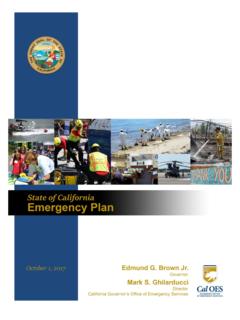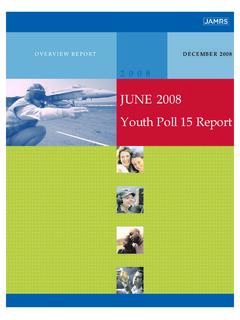Transcription of This page is intentionally blank. - Department of …
1 this page is intentionally blank. this page is intentionally blank. 1 Table of Contents Table of Contents California s Continuing Fiscal Challenge: An Opportunity for Change .. 1 Preserving Critical Programs: Building Upon the Success of A New Fiscal Blueprint for California s Future: Bridging the Gap .. 7 the 1991 State-Local Program Realignment .. 17 A Call for Structural 27 2003-04 Budget Summary Summary Charts .. 35 Economic Outlook .. 43 Revenue Estimates .. 51 Demographic 75 K-12 Education .. 77 Higher Education .. 91 Health and Human Services .. 101 Corrections and Law Enforcement .. 145 California Environmental Protection Agency .. 157 Natural Resources .. 163 Business, Transportation, and Housing .. 171 Technology, Trade, and Commerce .. 183 Judicial Branch .. 185 General Government .. 189 Capital Outlay .. 197 Information 203 Statewide Issues .. 215 Appendices and 217 December 2002 Mid-Year Spending Reduction Proposals .. Appendix 75 Governor s Budget Summary 2003-04 this page is intentionally blank.
2 GOVERNOR GRAY DAVIS January 10, 2003 To the Senate and the Assembly of the California Legislature: I submit for your consideration the Governor s Budget for 2003-04. Californians have proven time and again that there is no threat or crisis great enough to break our spirit. From devastating earthquakes, to deadly floods and firestorms, Californians have risen to the occasion, set aside personal concerns, and worked together to meet the challenge. Each time, we emerged stronger and more resilient as a community. California now faces the most serious fiscal challenge in its history. The choices are difficult and the consequences of those choices will affect generations to come. this challenge must and will be met by California s leaders. Over the past four years, working together, we have made critical investments in improving education, protecting public safety, expanding access to health care, and providing taxpayers with significant tax relief. With the pace of both the national and state economies continuing to languish, and no significant rebound in sight, California has experienced the most dramatic decline in revenues since World War II.
3 We bridged the budget gap last year with a mix of on-going and one-time solutions. this year, the problem is larger and the choices are more difficult. Every crisis presents an opportunity for change. Yes, we must pass a budget and close the gap. this budget presents a plan to do that. We would be failing in our duty to those who elected us, however, if we pass on the tough decisions and do nothing to permanently fix what we know to be broken. As California leaders address the fiscal crisis now before us, we must seize the opportunity to develop a new fiscal blueprint for California. We must design a new foundation for meeting the needs of an already-changed California. The future is now. The challenge is ours. I look forward to working with the Legislature to meet this task head on. Sincerely, Gray Davis STAT E CAPITOL SACRAMENTO, CALIFORNIA 95814 (916) 445-2841 this page is intentionally blank. January 10, 2003 Dear Governor: As Director of Finance, I submit to you the 2003-04 Governor s Budget.
4 Over the past four years, your budgets have made great strides in improving education, protecting public safety, expanding access to health care, and providing significant tax relief. Now, California faces a significant challenge brought on by declining revenues. this budget addresses California s fiscal crisis by proposing a budget that is balanced both in fiscal terms and in terms of the solutions to bridge the gap. It also strives for efficiency in the delivery of services, including elimination of obsolete programs, elimination of duplication of services, and realignment of program responsibility and funding to local government. Lastly, the Budget attempts to protect essential programs and core services from significant reductions. In particular, the Budget protects health coverage for children, public safety, and classroom instruction in K-12 education and higher education. I wish to convey my heartfelt respect for the staff of the Department of Finance and my thanks to their families.
5 this Budget represents countless hours of effort on their part. The staff s dedication to you and the people of this State is unparalleled. It has been an honor to work with them. I also wish to thank you for the privilege of serving you for the last four years and wish you well in the challenging year ahead. Sincerely, B. Timothy Gage Director this page is intentionally blank. California s Continuing Fiscal Challenge 1 California s Continuing Fiscal Challenge: An Opportunity for Change California has a proud history of weathering crises and emerging stronger and more resilient than ever. this experience confirms that at the heart of every crisis is the opportunity for change. It is clear now that the and California economies are taking longer than ex-pected to recover from the current downturn, and the stock market has lost a considerable amount of ground since mid-year. this has resulted in a significant downward revision in State revenues. General Fund revenues from the major tax sources are expected to fall to $ billion in 2003-04 far below the level of income the State expected to receive in the budget year as recently as the 2002-03 May Revision.
6 this decline is by far the most dramatic loss of revenues California has experienced since World War II. this delay in the recovery of the national and state economies and a tax structure heavily reliant on volatile revenues have resulted in a budget shortfall in the current year and budget year totaling $ billion. As California addresses this unprecedented fiscal crisis, we must seize the moment of opportunity that exists to make critical, neces-sary changes. But change should not be an end unto itself. Change must be part of a vision that continues to move California forward. California can emerge from this crisis with stronger communities, more efficient govern-ment, and a new blueprint for meeting the challenges ahead. But we will succeed only if we are willing to set aside partisanship and put California s future first. Figure A Major General Fund Revenue Growth 1989-90 to 2003-04 -20% -15% -10% -5% 0% 5% 10% 15% 20% 25% 1989-90 1990-91 1991-92 1992-93 1993-94 1994-95 1995-96 1996-97 1997-98 1998-99 1999-00 2000-01 2002-03 2003-04 Actual Estimated 2001-02 Governor s Budget Summary 2003-04 2 California s Continuing Fiscal Challenge Resolving the Immediate Fiscal Crisis The 2003-04 Budget closes the $ billion budget gap and reflects five key elements: It is balanced, whereby expenditures match available revenues.
7 It includes difficult, but balanced decisions including: cuts/savings ( ), State-local program realignment ( ) with dedicated revenue sources, fund shifts ( ), transfers/other revenue ( ), and loans/borrowing ( ). It includes revenue increases only for local government. There are no tax increases for State government in this Budget. It contains a $531 million reserve. It substantially eliminates the anticipated $12 billion structural shortfall be-tween revenues and expenditures in 2003-04. Ensuring California s Long-Term Fiscal Integrity this Budget reflects a bal-anced spending plan for 2003-04, and calls for the development of a new fiscal blueprint for California s future: It calls Californians to action to reform both our existing revenue and expendi-ture policies to enable the State to provide for the needs of its citizens in the future, especially during periods of economic downturns. It seeks structural reform in State and local governance and finance to achieve more rational and responsive service delivery systems.
8 It proposes restoration of Executive Branch authority to make mid-year adjust-ments to the Budget when revenues fall significantly below budgeted forecasts. It urges the creation of a special budget reserve for proceeds from extraordinary revenue growth to be used for one-time expenditures. Primary Features of the 2003-04 Governor s Budget A Balanced Approach Closing a $ billion budget gap requires a balanced solution and consideration of every available option. In addressing the current shortfall, some might urge closing it predominantly with one-time versus ongoing solutions. this approach cannot work this year since most of the one-time ap-proaches have been exhausted. Moreover, with the economy rebounding much more slowly than predicted by forecasters last year, additional reliance primarily on one-time fixes would only exacerbate the underlying structural imbalance we face going forward. Governor s Budget Summary 2003-04 California s Continuing Fiscal Challenge 3 Others will suggest that our budget problem must be solved solely with program reductions regardless of the cost or consequence.
9 Cuts will, of course, be part of any solution, but a shortfall of this magnitude cannot be solved with reductions alone without seriously damaging the education of our children, our ability to protect public health and safety, our commitment to provide health care for our children, and protection of our environment. Still others would advocate closing the budget gap completely with tax increases. this would not be responsible and could further delay California s economic recov-ery. Furthermore, even if every tax increase considered by the Legislature last year were adopted, the additional revenue generated would not even close 50 percent of the shortfall. this Budget contains difficult and controversial elements. However, it rejects rigid ideology and reliance on unrealistic solutions. Instead, this Budget presents a balanced combination of steps needed to meet this enormous challenge. The 2003-04 Budget includes the following: Substantial reductions in spending Even with the other solutions contained in this Budget, these reductions are necessary to help eliminate the structural imbalance between revenues and expenditures going forward.
10 Increases in revenues for local governments All of the proposed tax in-creases in this Budget are dedicated to local governments to preserve key programs pursuant to the State-Local Program Realignment. this realignment is intended to provide greater local program responsibility as well as greater flexibility in program administration and service delivery. Less reliance on loans and borrowing this Budget relies less on loans and borrowing than in previous years to address budget shortfalls. Spreading reductions to programs across all areas of State government Virtually all programs contribute to the solution. Key Priorities Protected With a shortfall of this magnitude, no area of the Budget can be held harmless. However, the Budget minimizes the impact of reductions to the greatest degree possible in several key program areas: K-12 Education Education remains this Administration s first priority. How-ever, given the magnitude of the budget shortfall, the Budget does make reductions to K-12 education, accounting for percent of all solutions to close the budget gap significantly less than its proportionate share of General Fund spending ( percent).



![[Page Intentionally Blank] - Police Executive …](/cache/preview/6/9/5/6/0/0/0/f/thumb-6956000f3f6abdc7d6fe85fa330b8ad5.jpg)








